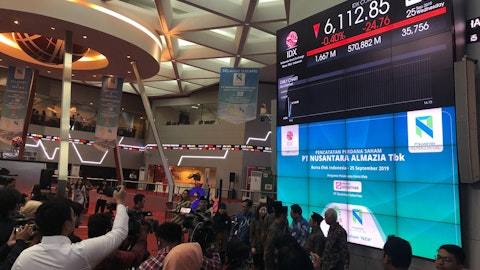David Koning: No, that’s helpful. And we always look at that as a positive. When you’re paying out, it usually means the results have been pretty good from those. So nice job. Thank you.
Operator: And one moment for our next question. And our next question comes from David Grossman from Stifel. Your line is now open.
David Grossman: Thank you, good morning. If we could just go back to some of the more fundamental things around your commentary on Gen AI. I think I understand what you’ve been saying about how it’s impacting the demand from your customer base and some of the use cases. Perhaps you can spend just a few minutes on what do you see as being the secular impact it may have in your business model? I’m thinking contracting risk margins and just how the business is operated overall and how that flows through the P&L and the balance sheet. And maybe there’s no change. Maybe this is just another technology wave that will impact the business model in a similar way. Just curious whether or not this may be different. And if so, how?
Rohit Kapoor: Sure, David. So you’re absolutely right. Look, there are two fundamental changes taking place. One is the macroeconomic environment and the second is the adoption of Gen AI. On Gen AI, I think our business model is certainly going to evolve and change. Certainly, there will be a lot more investment that’s going to be required to be able to create some of these adapters and solutions that clients will expect to be prebuilt and that they will not be funding themselves. And at the same time, there will be a lot more risk sharing that will be there. So, it’s going to be a lot more contingent on us being able to deliver the outcome and the business benefit to our clients. I do think the shift in the commercial models will take place gradually, but perhaps the first change is going to be to shift from a time and material type of contract towards more fixed price kind of contracts or even initial upfront investment by us on repeatable adapters and accelerators that we need to invest in.
From a margin standpoint, I think initially, because of the investment and because of our ability to demonstrate impact for our clients, the margins would be initially low, but over a period of time, because the value that we can deliver with Gen AI is significantly higher, we would expect the margins to actually go above our corporate average. So as we scale up the business, I think this becomes a much more attractive business for us to be kind of going into. It’s much higher value added, it’s much more defensible and it’s going to have a much better margin characteristics. Of course, it’s dependent upon our ability to execute and our ability to demonstrate the results. It’s also a business that’s going to involve a lot of continuous change because with Gen AI, as you know, the LLM models keep changing every couple of weeks.
And so we’re going to see more models kind of come in. We’re going to see more and different ways in which these are going to get adopted. So the obsolescence is also going to increase in this space. And therefore, the ability to remain nimble and modular, I think, is going to be critical for the long-term success in this space. So it’s certainly got very different characteristics. And I think as Gen AI continues to evolve over the next 1, 2, 3, 5 years, it’s going to look — the business is going to look and feel quite different as we go along.
David Grossman: And have you experienced the margin dynamic yet through a full cycle, meaning that you had to kind of go through the process of building or prebuilding a solution or a diopter and seeing the deployment and then seeing the margins lift above the corporate average? Or is this still on kind of your expectation based on what you’re seeing in the market, but we’re just not there yet?
Rohit Kapoor: No, David, we’ve seen that. So one of the solutions that we built is PayMentor, which helps our clients collect their receivables and it’s an entirely digital and an AI-based solution. We had very low margins on that piece of service line initially. And now that we are operating that at scale across multiple clients, our margins on that piece are higher than the corporate average. So, we are seeing this on solutions that are getting adoption and which are getting to size and scale. But obviously, those solutions that do not get to size and scale, those investments are things that we will have to recover through the ones that are successful. So it’s going to be a portfolio approach for us.
David Grossman: Any metrics that you can disclose in terms of where the portfolio is today on that journey in terms of how many…
Rohit Kapoor: It’s still too early for us on that, David, to be able to disclose that. But when we meet for our Investor Strategy Day on May 7, we will be actually unpacking some of this for you.
David Grossman: Great. Thank you. Just one little quick thing. So I know we’re going over here. Just on the working capital comments in terms of the cash flows in the quarter. Is that related to this dynamic of having to invest in some of these prebuilt solutions? Or is that something just totally different in the quarter?
Maurizio Nicolelli: No, David. It’s more kind of onetime items that came through in the quarter and more working capital requirements. It’s not really related to our investment process. Our investment process is ongoing. Well, obviously, we’re investing more, particularly into AI this year, but it’s not related to that.
David Grossman: Got it. Thanks very much.
Operator: And thank you. And one moment for our next question. And our next question comes from Mayank Tandon from Needham. Your line is now open.
Mayank Tandon: Thank you. Good morning. Thank you for squeezing me in. I have just a couple of quick ones. One, Rohit, you mentioned earlier about rightsizing the workforce given the news out there earlier in the month. I just wanted to get a sense of as you think about upskilling and retooling our workforce in anticipation of some of these Gen AI related engagements, who are you looking to hire? And where are you finding the talent from? Just any sense in terms of your recruiting engine and what some of the changes might take place over time as you position for growth from some of these Gen AI platforms?




